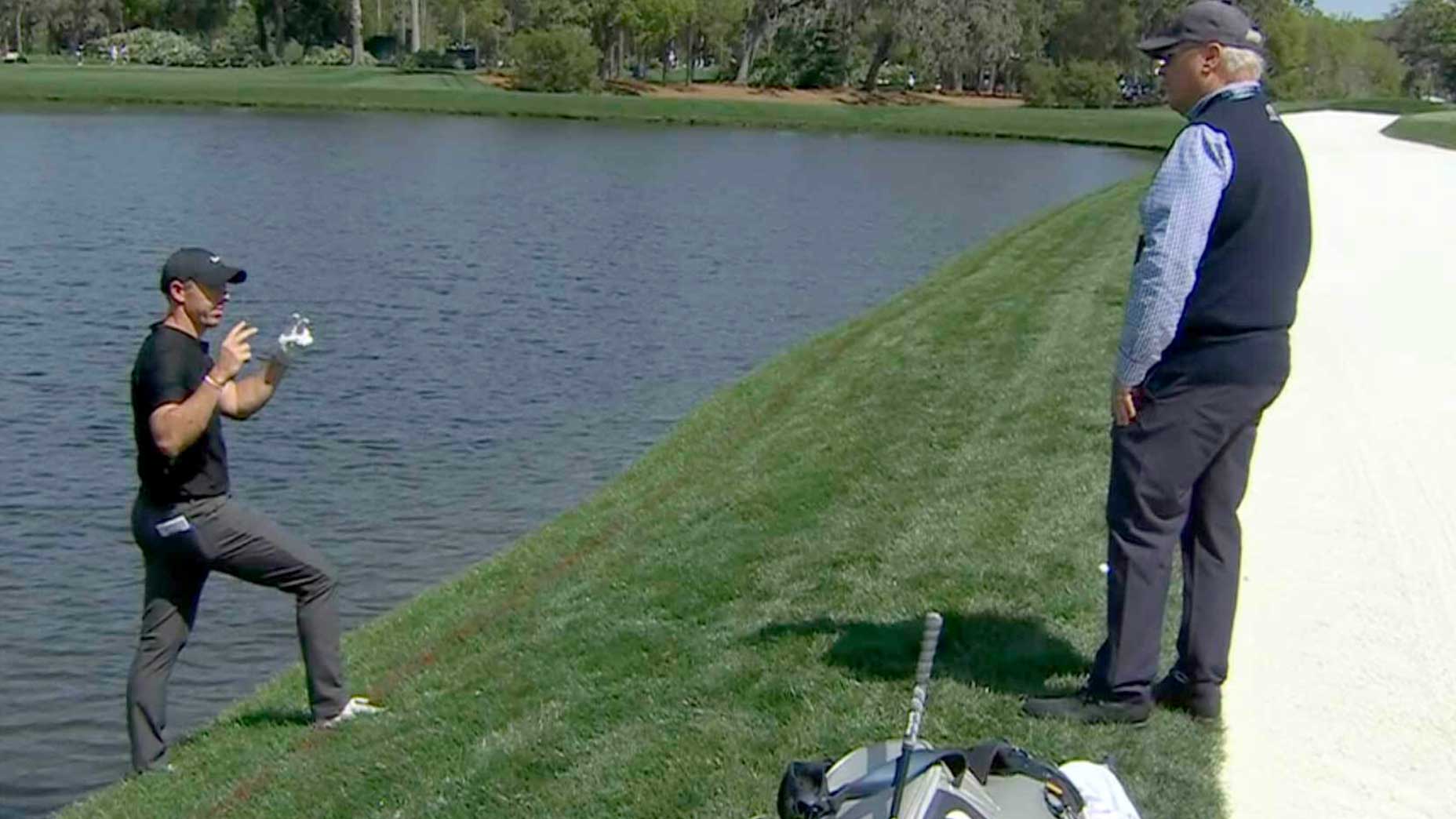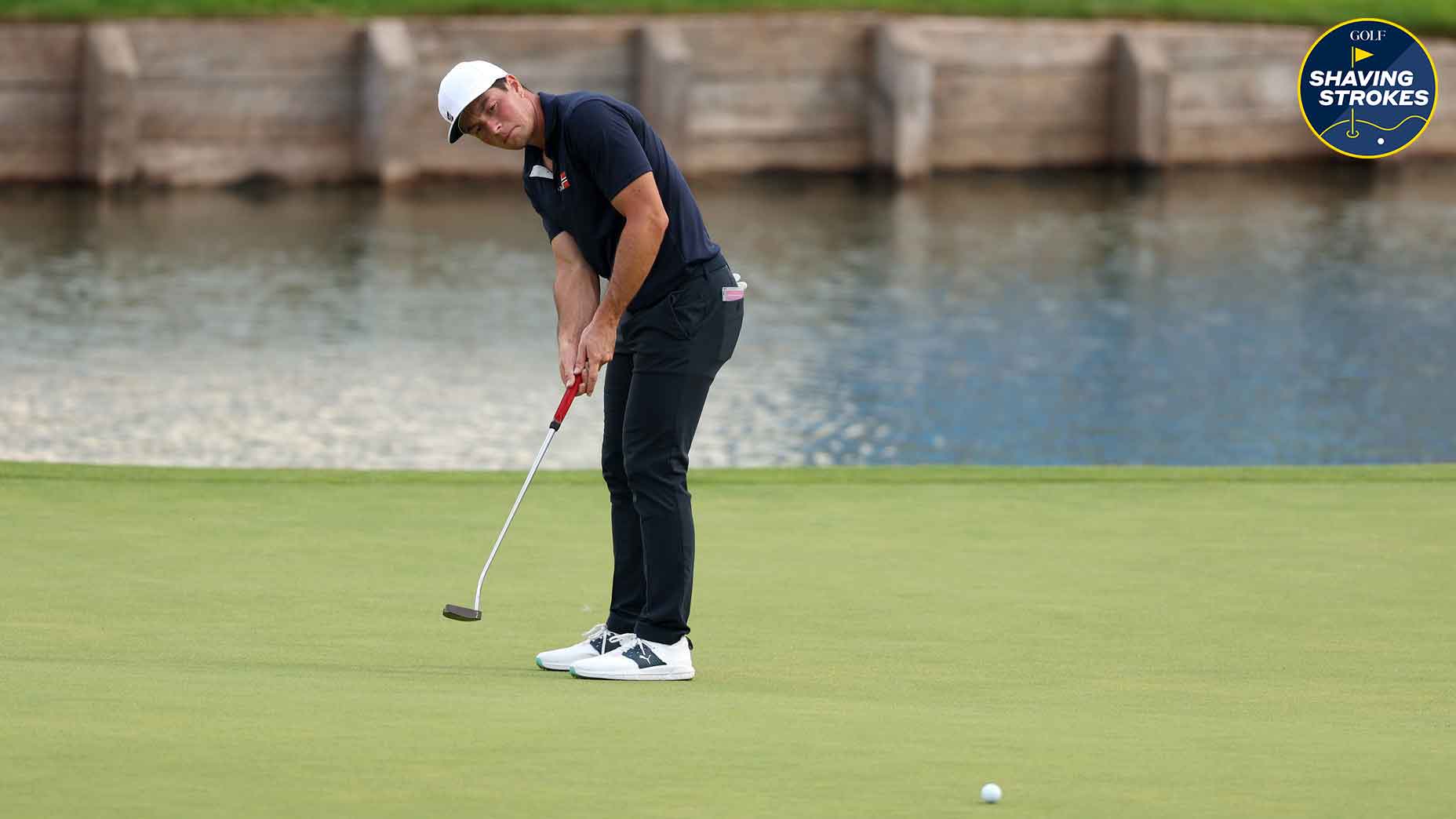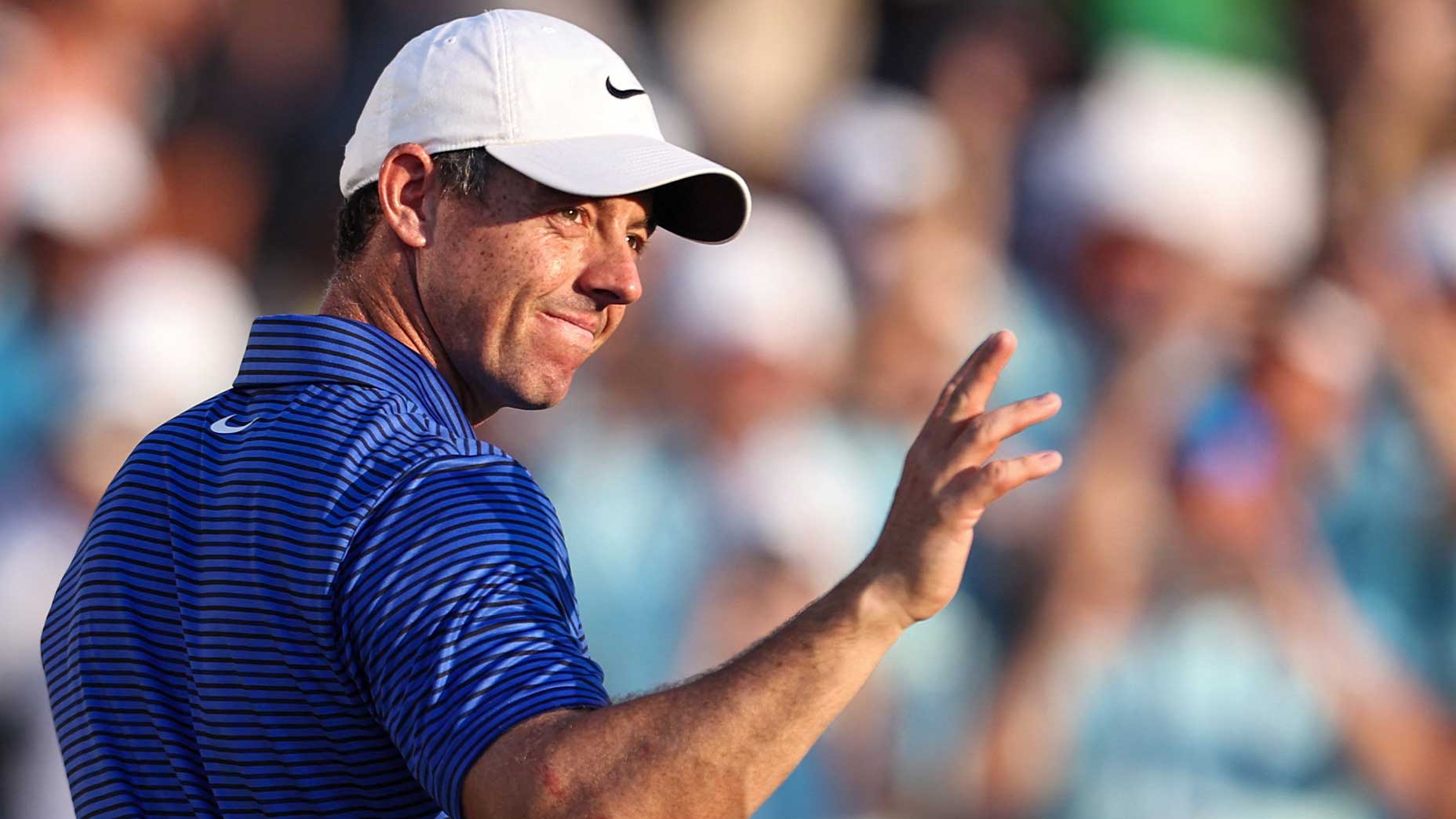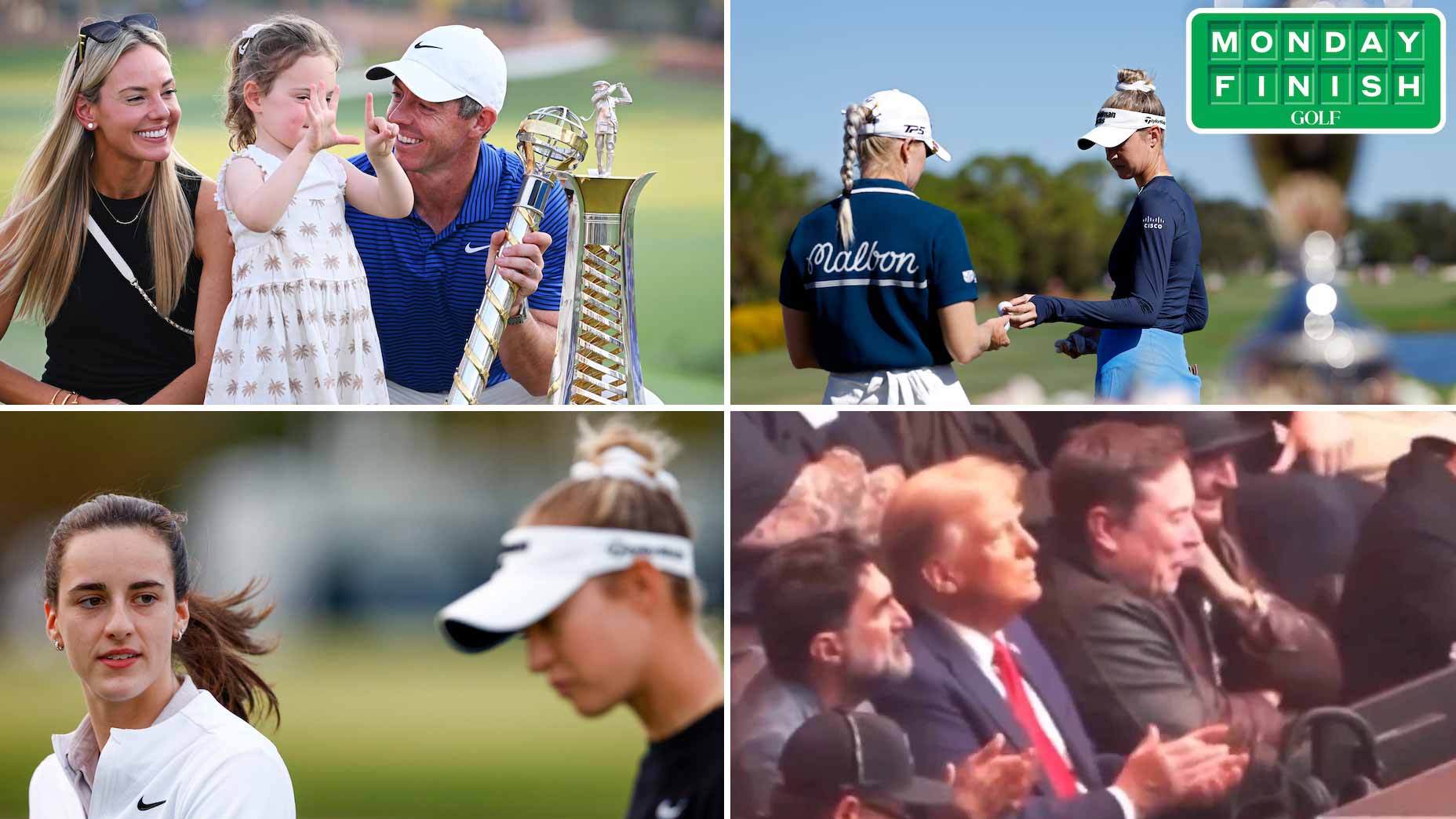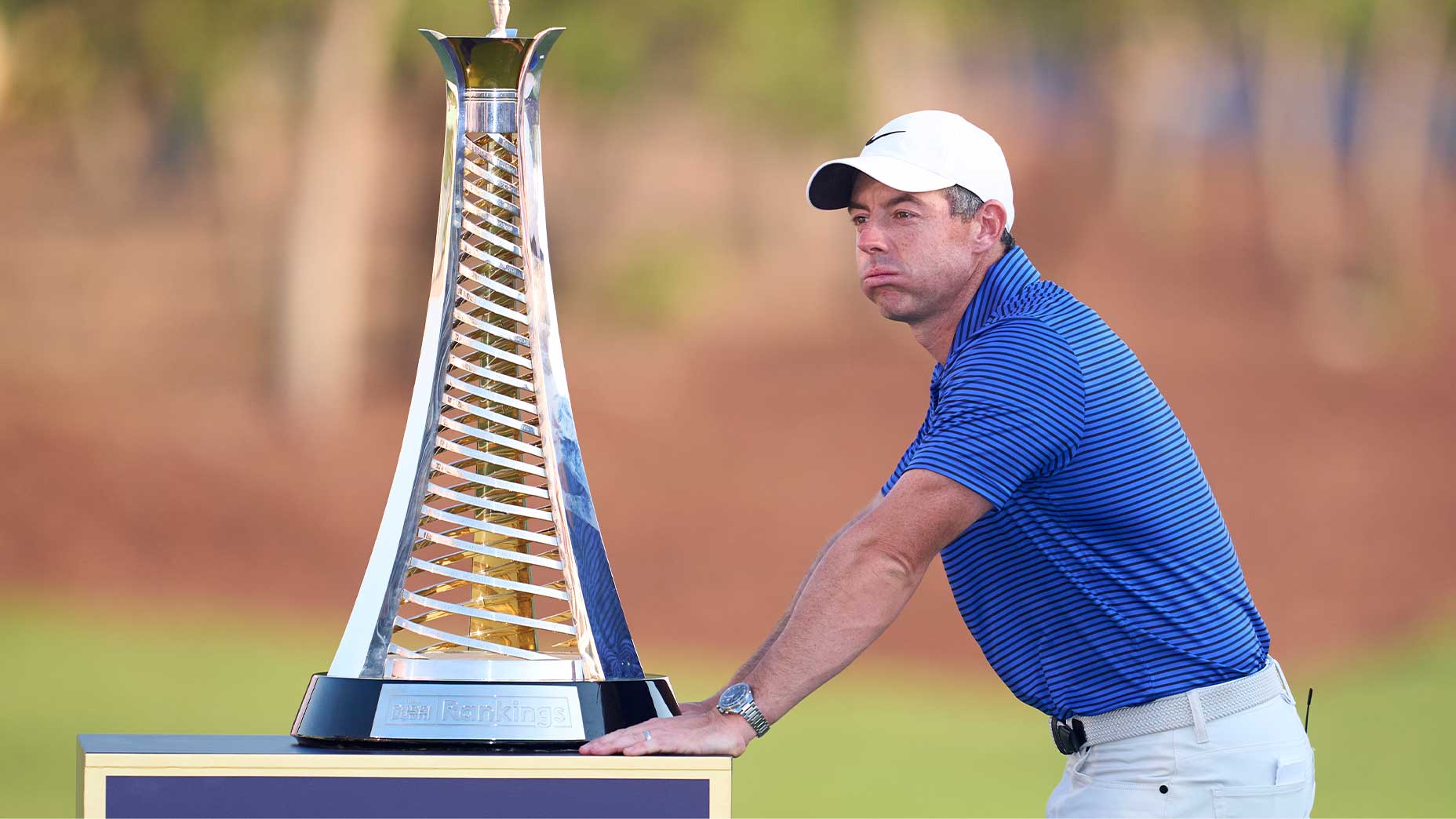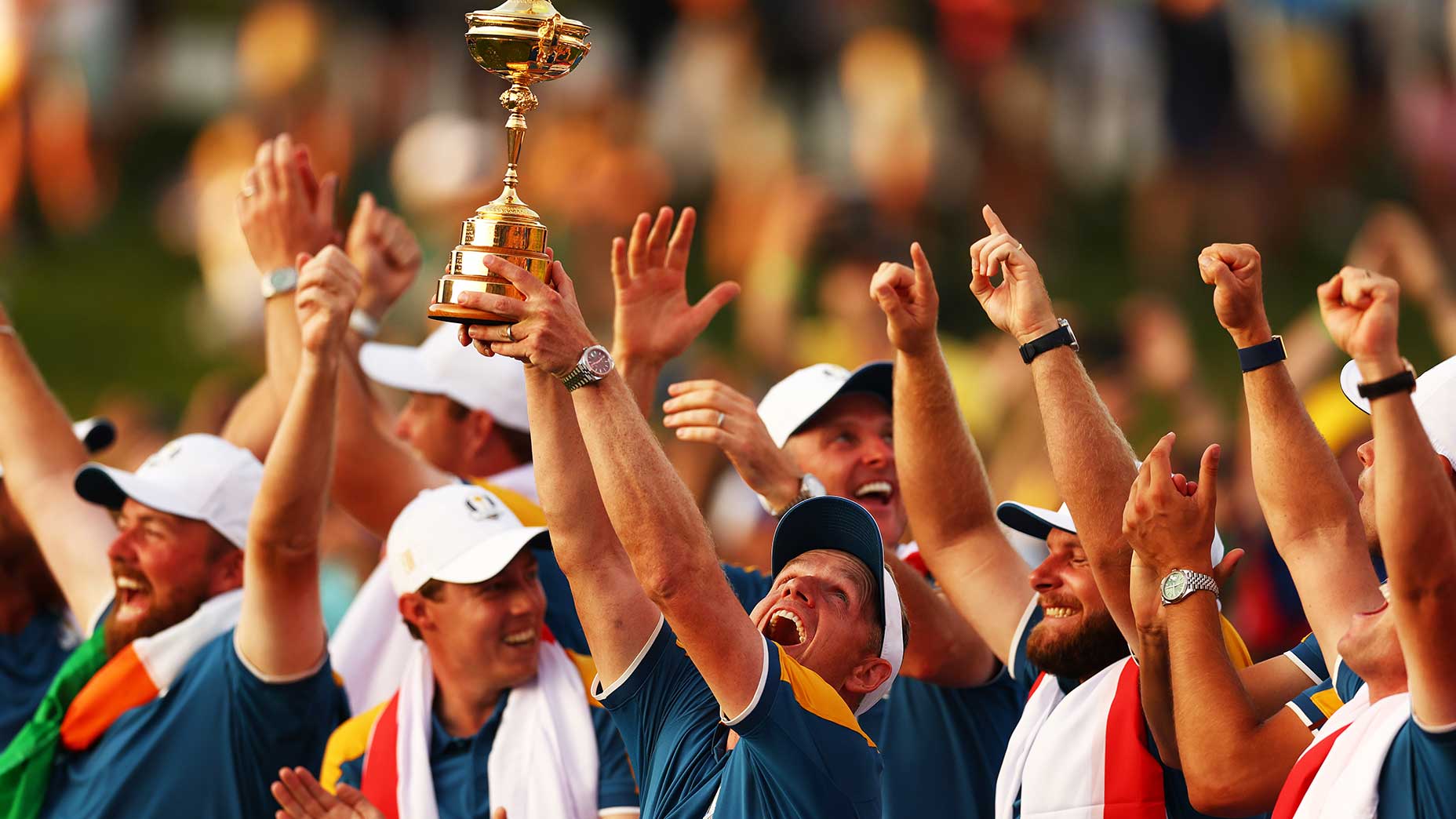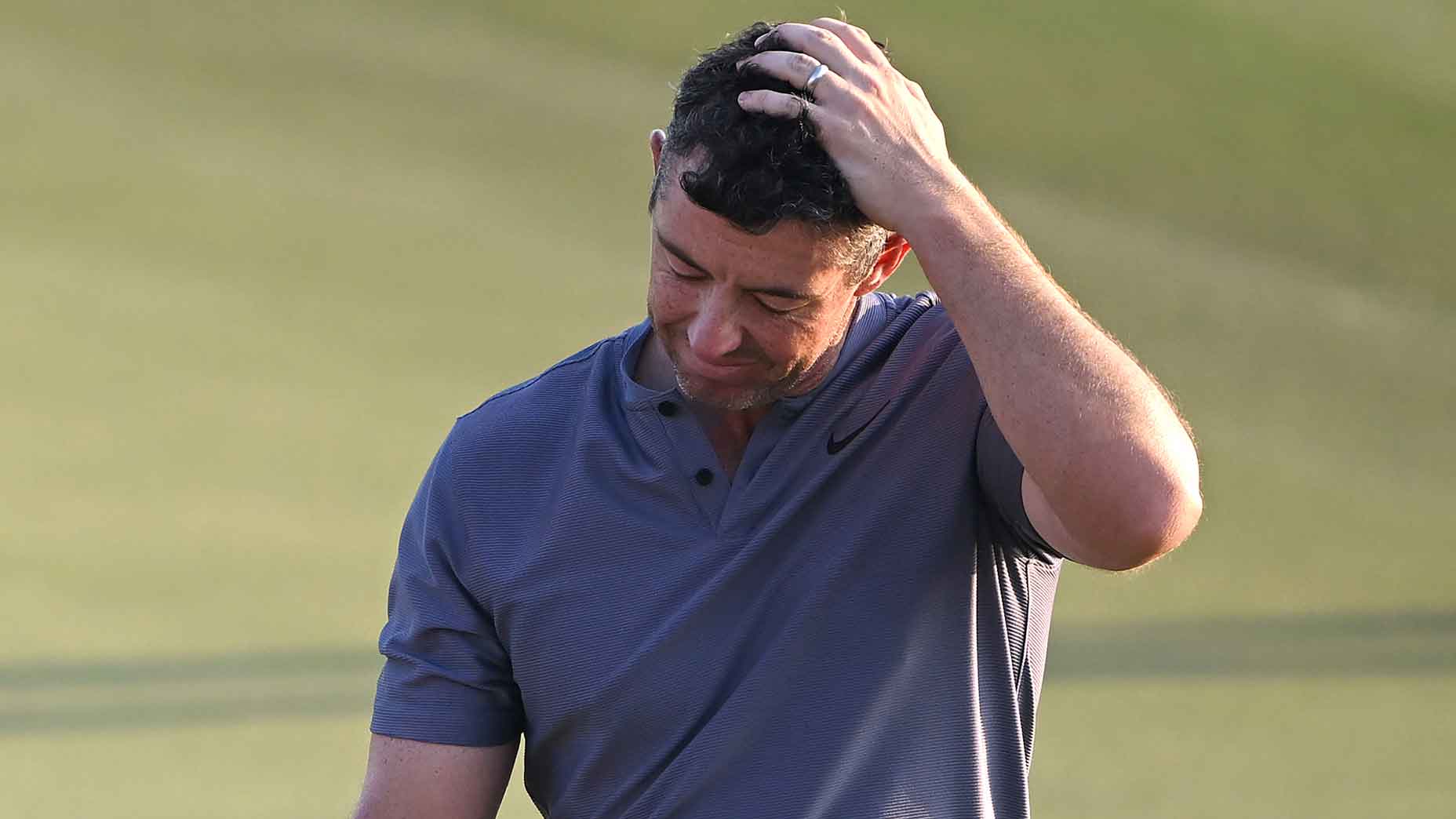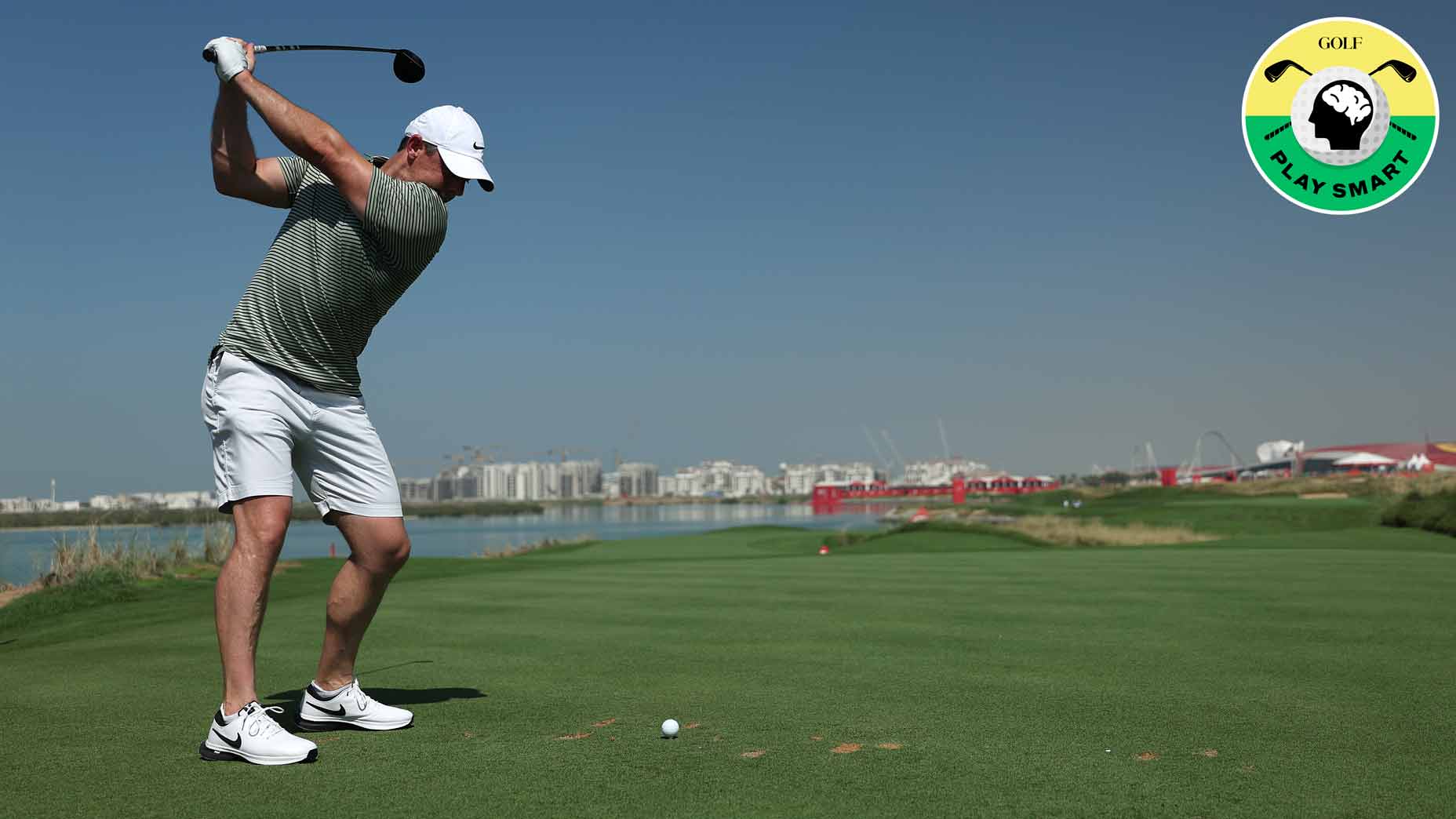Rory McIlroy rules-policing makes for tense theater at Players Championship
- Share on Facebook
- Share on Twitter
- Share by Email
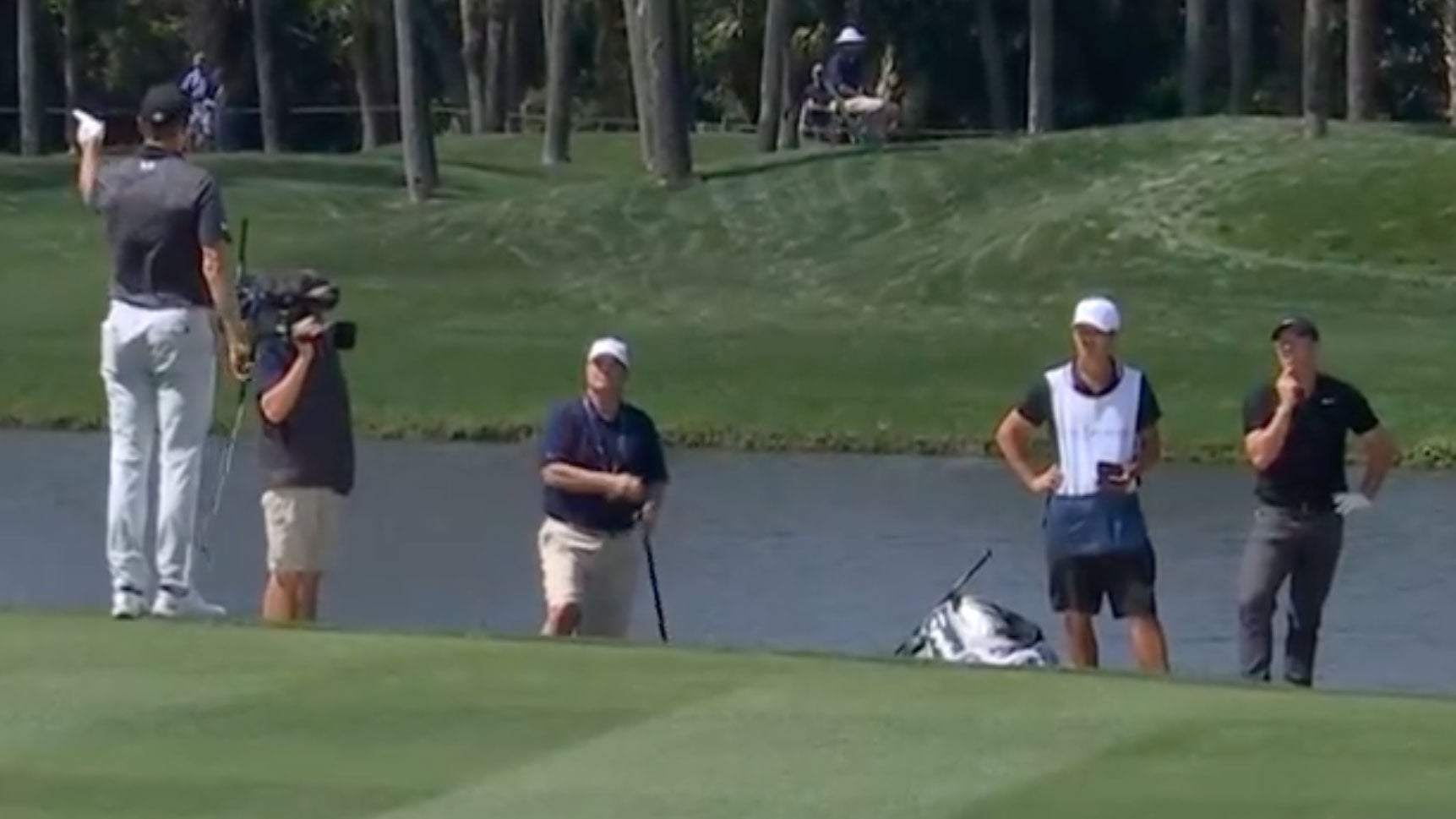
Jordan Spieth, far left, and Rory McIlroy, far right, discussing McIlroy's drop on the 7th hole at the Players Championship.
ESPN+
PONTE VEDRA BEACH, Fla. — Rory McIlroy was cruising. After six birdies in his first eight holes at this 50th Players Championship, he had at least one press-tent typist googling the Stadium Course’s course record (Tom Hoge, 62, 2023). Red numbers were coming so easily to the world’s No. 2 that on an idyllic Thursday morning on Pete Dye’s masterwork the “P” in TPC could have stood for “Pushover.”
Then came McIlroy’s ninth hole of the day, the par-4 18th.
The tee shot at Sawgrass’ par-4 closer, where a lake guards the entirety of the left side of the fairway, is among the most daunting in golf, even for the game’s most talented driver. McIlroy could have played it safe and hit a 3-wood or even an iron, but he has been swinging the longest club in his bag with such swagger of late that you couldn’t fault him for playing aggressively.
You know where this is going. McIlroy’s blast started on the edge of the lake line and never left it.
Kerplunk.
After seeing the fate of his ball, McIlroy turned to his caddie, Harry Diamond, and said, “Did it cross?”
As in, did his ball cross into the water well up the fairway, or was the point that his ball last covered terra firma just beyond the tee box? The former spot would result in a drop that would allow McIlroy to get home with his third shot; the latter would not. Trouble was, the appropriate drop wasn’t obvious, either to McIlroy or his playing partners, Viktor Hovland and Jordan Spieth. But among them it was their duty to make a call.
Golf’s a funny game like that. TV cameras can, and sometimes do, provide players assistance when the naked eye is insufficient. But in this case, replays provided no such aid. That left it to McIlroy, Hovland, Spieth and their three caddies to determine the path of McIlroy’s ball.
“I don’t know how far it was in,” Hovland said toward the beginning of a lengthy debate. “Kind of where that bird is?”
“Yeah,” McIlroy said.
Hovland: “I don’t know if it’s going more diagonally left or…”
McIlroy: “Because it was turning a little bit.”
By this point, McIlroy was looking some combination of flummoxed and concerned. He had his hat off and was running his hand through his hair.
Hovland: “Yeah, it definitely was. The wind’s off the right.”
After a couple of more references to stakes and birds from Hovland and Spieth, Spieth weighed in.
“It’s just hard to tell where it is in space,” he said pointing skyward down the fairway. “So it’s going to be your call on that.”
“Yeah, I know,” McIlroy said.
Spieth again: “In the air it was even with the red stake at the tee, so I don’t know think it was past the red stake because of that.”
McIlroy: “But I think it’s sort of—”
McIlroy made a curving motion with his right hand.
“—I think it’s between the birds and the red stake. Like, that’s sort of my—”
“You have to make the call,” Spieth said.
“That’s what I saw,” said a new voice. It was Hovland’s caddie, Shay Knight, who was standing behind Spieth.
“Thank you,” McIlroy said.
And that was that. With the group seemingly in agreement — or at least as close as to an agreement as they were going to come — they proceeded down the fairway. McIlroy took his drop approximately 170 yards from the tee, which left him 293 to the hole. He knocked a 3-wood onto the front of the green and two-putted for bogey.
Rattled? Not Rory. He quickly rediscovered his groove, birdieing three of his next six holes to move to eight under as he stared down his tee shot on the watery par-4 7th.
And that’s when it happened again, on yet another hole lined by water left.
Kerplunk.
This time, though, the debate was less about where McIlroy’s ball had crossed — the general vicinity was not in question — and more about whether the ball had bounced above or below the red paint line that marked the penalty area. Above the line would mean a drop that would leave McIlroy roughly 225 yards from the hole, while below would have McIlroy dropping back near the tee box. Once again, the players couldn’t say with certainty what had transpired, and once again, ESPN’s cameras were of no help.
After McIlroy had dropped and was preparing to play his third shot, Hovland crossed to fairway to ensure that McIlroy’s had indeed bounced above the line.
“I don’t know for sure that it crossed the line,” he said.
McIlory said. “I’m pretty comfortable that I saw it above the red line,”
“I thought it was very close,” Hovland said. “I thought it was very speculative.”
Rory McIlroy, Jordan Spieth and Viktor Hovland discuss McIlroy's drop on No. 7.
— PGA TOUR (@PGATOUR) March 14, 2024
Rory makes double bogey to move from solo leader to T2. pic.twitter.com/dkV6a5Q22W
After a bit more chatter, Spieth joined the discussion.
“Everyone that I’m hearing that had eyes on it…is saying they’re 100 percent certain it landed below the line,” he said.
“Who’s everybody, Jordan?” McIlroy said, sounding mildly agitated. “Who are you talking about?”
Spieth pointed back across the fairway toward members of the ESPN crew.
“TV, all these guys,” Spieth said. “They’re saying they [saw it with] their eyes. They didn’t see it on camera, they’re saying what they saw, which again, it, like, doesn’t mean anything — it’s what you guys think happened.”
At this point, a rules official arrived, not that he could provide much help.
“We’ve got no evidence,” the official said, “so you’ve got to go with what you saw.”
Spieth stressed that he wasn’t questioning the drop so much as he didn’t want to see McIlroy get penalized for taking an improper drop, as had happened to McIlroy earlier this year at the AT&T Pebble Beach Pro-Am.
The debate ensued for another four minutes before McIlroy ultimately played his third shot from the spot where he originally had taken his drop. That led to a double-bogey 6. After one more birdie, at the 9th, McIlroy signed for a seven-under 65 that gave him a share of the first-round lead with Xander Schauffele.
Rory McIlroy defends himself after ‘blind spot’ rulingBy: Sean Zak
After his round, McIlroy was asked if he thought Spieth’s policing at 7 was “needless.”
“I think Jordan was just trying to make sure that I was doing the right thing,” McIlroy said. “I mean, I was pretty sure that my ball had crossed where I was sort of dropping it. It’s so hard, right, because there was no TV evidence. I was adamant. But I think, again, he was just trying to make sure that I was going to do the right thing. If anything, I was being conservative with it. I think at the end of the day we’re all trying to protect ourselves, protect the field, as well. I wouldn’t say it was needless. I think he was just trying to make sure that what happened was the right thing.”
McIlroy’s response was a balanced recounting of what had transpired, but it also got at the root of what makes golf unique from virtually every other sport: field self-protection. Imagine NFL players having to litigate whether one of their opponents jumped offside or interfered with a receiver. Or an NBA team weighing in on whether an opponent traveled or committed a technical foul. Golf is exceptional in that way, especially at the PGA Tour level where these trials-by-peers play out on camera, like episodes of People’s Court. It’s riveting theatre, or at least this correspondent finds it to be, because how players respond to questions from their opponents in the heat of competition can be windows into their souls.
After the lengthy conversation with his playing partners on 7, McIlroy admitted that he began to doubt himself. “I was like, okay, did I actually see what I thought I saw,” he said. He added: “I was adamant that I saw it bounce above the red line, but then when someone comes in and says, well, someone thought that it didn’t, then you’re, like‚ it just puts some doubt in your mind. Again, it’s up to you to be comfortable enough with your decision that you did see what you saw.”
Neither Hovland nor Spieth spoke to the media following their rounds, but McIlroy said he believed he and his playing partners were comfortable with how the episodes at 18 and 7 were resolved.
“I think so, yeah,” McIlroy said. “I’m comfortable. I think that’s the most important thing.”
Latest In News

Alan Bastable
Golf.com Editor
As GOLF.com’s executive editor, Bastable is responsible for the editorial direction and voice of one of the game’s most respected and highly trafficked news and service sites. He wears many hats — editing, writing, ideating, developing, daydreaming of one day breaking 80 — and feels privileged to work with such an insanely talented and hardworking group of writers, editors and producers. Before grabbing the reins at GOLF.com, he was the features editor at GOLF Magazine. A graduate of the University of Richmond and the Columbia School of Journalism, he lives in New Jersey with his wife and foursome of kids.

